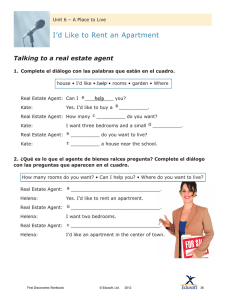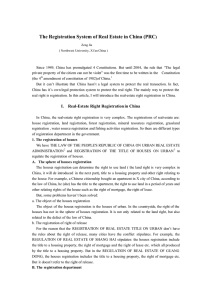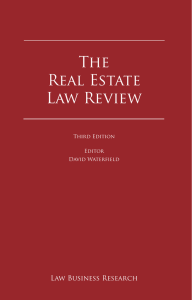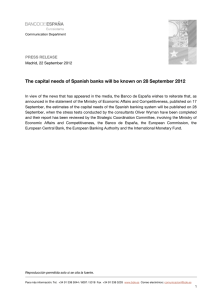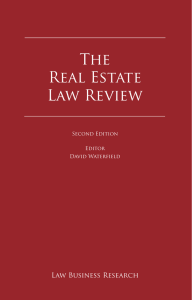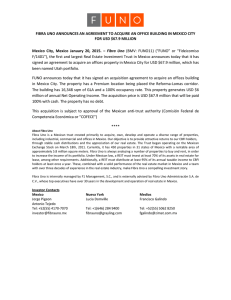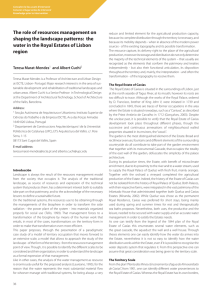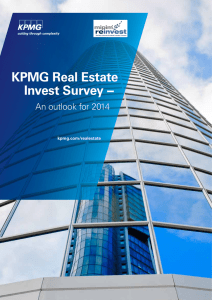Doctorado en Finanzas de Empresa THE EFECTS OF REAL
Anuncio
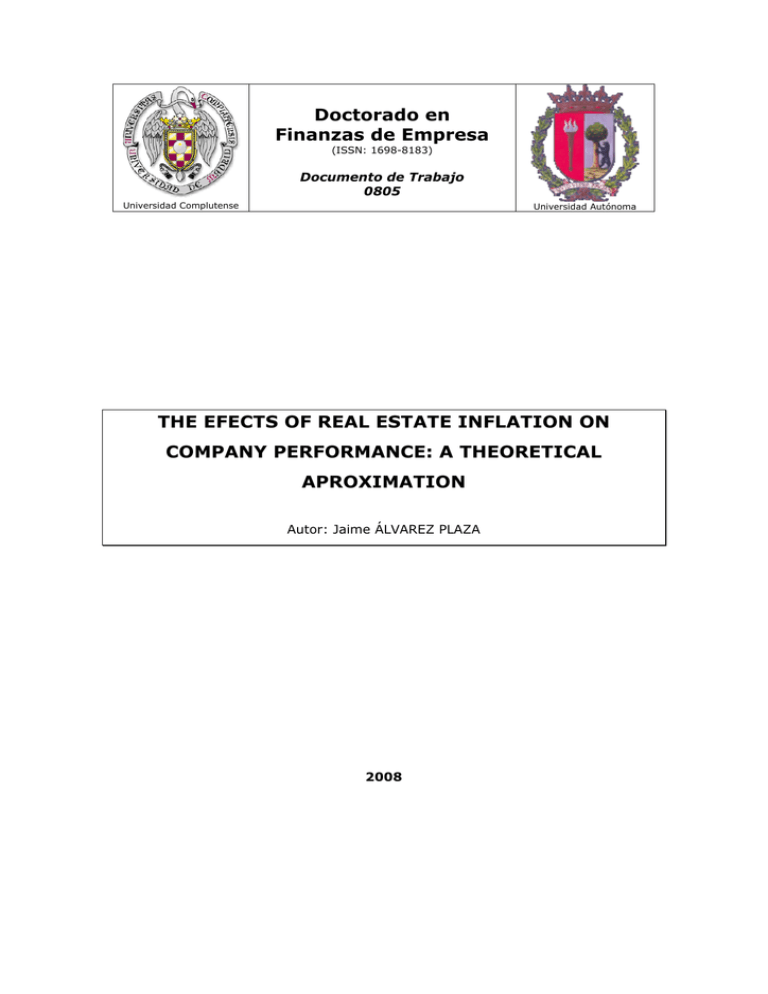
Doctorado en Finanzas de Empresa (ISSN: 1698-8183) Documento de Trabajo 0805 Universidad Complutense Universidad Autónoma THE EFECTS OF REAL ESTATE INFLATION ON COMPANY PERFORMANCE: A THEORETICAL APROXIMATION Autor: Jaime ÁLVAREZ PLAZA 2008 The Effects of Real Estate Inflation on Company Performance: A Theoretical Approximation Jaime Alvarez, Universidad Complutense, [email protected] Abstract: Real estate assets are, and have traditionally been, viewed in one of two ways: either as a consumer good or as an investment. A third distinguishing feature, however, can arise when these assets are utilized by a business as part of its operations, that is to say, when a company or business needs a real estate asset to pursue its business activity. Corporate Real Estate (CRE) should therefore be considered part of a company’s productivity framework and one of the many operational factors affecting a company’s performance. The purpose of this paper is to offer a theoretical approach for evaluating the effect that changes in the price and value of real estate holdings can have on a company’s asset management and, subsequently, on its performance. JEL: E31, G31, G32, L25 Key Words: Corporate Real Estate, Company Performance 2 1. Introduction The real estate market is a key element in a nation’s economy. In the case of Spain, eighty percent of families own their own homes and these represent between sixty and seventy percent of a householder’s total assets as well as being the collateral for a high proportion of householder liability (Martínez and Matea, 2002). Given its relative importance, changes in real estate prices, including that of housing, have potential implications for the macroeconomic and financial stability of the national economy (Ayuso et al, 2003). In the case of Spain, the significance of housing is even more evident given that according to a household budget survey conducted in 20011, 85% of housing was owner-occupied compared to 9% in rental use. Moreover, the fact that this asset can be considered a consumer durable as well as an investment asset is a special feature which merits special attention (Ayuso et al, 2003). The characteristics that define the real estate market as an investment good are twofold. Firstly, a property is a capital good, in the strict sense of the term, if it generates wealth per se through a lease or rental agreement. Secondly, property can be considered a business investment if it is part of the assets through which a company can generate wealth by pursuing its business activity. The study of this latter characteristic of real estate as a business investment is the object of this paper and will be combined with a theoretical analysis of the effect of variations in the value of this investment on company performance. Thus the use of the term Corporate Real Estate (CRE) to refer to the investments in real estate made by a company which, according to Miles et al (1989), can affect a number of economic and financial variables such as cost of capital, debt capacity, leverage, systematic risk and the book-to-market value ratio of the corporation. 1 Encuesta de Presupuestos Familiares 2001 (Martínez and Matea, 2002) 3 The body of literature on asset management and the impact of the real estate market on company performance includes a number of studies useful to the object of this paper. The first is based on the work of Zeckhauser and Silverman (1983) which laid the foundations for corporate real estate composition and management. It found that by and large American corporations did not specifically manage their real estate holdings and that many did not even have a comprehensive inventory of such holdings. Johnson and Keasler (1993) describe and consider the weighting of asset subtypes that make up a company’s real estate portfolio. Bon (1994) establishes a set of principles for successful CRE management and McDonagh (2002) suggests a model for managing CRE and measuring CRE asset management performance. According to Hill (2001), a significant proportion of corporate real estate is owned by corporate occupiers. Although this is sometimes the result of financial planning, using property to hedge against inflation or to take advantage of capital gains in the future, it is more often the case that property has accumulated through pure inertia or lack of management focus. Consequently, and for many companies, real estate is not creating shareholder value but is instead perceived as an operational risk. A second related area involves studying the wealth effect as it affects consumer behaviour. Bathia (1987), Bertaut (2002), Juster et al (2005) and Chaney et al (2007) consider the effects of increased property values and the consequent perceived increase in wealth by both family and corporate consumers as the basis for certain consumer behaviour which has led to consumption growth and reduced savings. The third area of study refers to the effects of a company’s real estate portfolio on financial parameters such as stock value [el valor de las cotizaciones], risk or company performance. Miles et al (1989), for instance, examines the role of CRE in the corporate financing framework based on its relationship with debt, leverage and risk and Allen et al (1993) looks at leasing operations and their effect on shareholder value. Rodríguez and Sirmans (1995) provide a thorough review of the literature relating to the impact of CRE decisions based on evidence from capital markets, concluding they have a significant impact on shareholder wealth. Lizieri and Satchell (1997) focus on the interaction between the property stock market and the equity market and examine the role of real estate assets on the economy. They conclude that real estate assets have a clear impact on the business sector. Cheong and Kim (1997) investigate the relationship between results, systematic risk and the proportion of shareholder equity to real estate holdings of a non-real estate company finding no evidence to suggest that this ratio significantly affects returns although Liow (1999) observes that this ratio does affect asset structure, capital 4 structure and the stock value in those non-real estate companies in which property holdings account for at least 20% of company assets. Deng and Gyourko (2000) investigate the difference in performance by companies with greater and lesser weighting of real estate assets and Hiang (2004) concludes that the inclusion of real estate in a corporate portfolio appears to be associated with lower returns, higher total risk, higher systematic risk and poorer abnormal return performance. Nonetheless, no references in the literature have been found to date on the effects that higher company value resulting from real estate inflation can have on company performance and operational decision-making, in line with the purpose of this paper. This paper hopes to provide an analytical review of the elements that make up the corporate real estate market, firstly by looking at real estate price increases to determine the rate of inflation affecting these assets and secondly, by looking at the financial concepts and indicators relevant to corporate real estate. Finally, there follows a theoretical analysis of the effects that real estate inflation can have on corporate returns. 2. Corporate Real Estate (CRE) Real estate is commonly defined as having a double function, that is, as a business investment and a consumer durable (Ayuso et al, 2003). But it is often forgotten that real estate is also a factor of production, as a support to many business activities and thus can also be said to combine the properties of utilization and investment. The CRE market includes all real estate that support business activities whether they are the core business, as in the case of a real-estate company, or which simply support the productive or administrative functions of a business. The concept of Corporate Real Estate (CRE) will be used to refer to these business assets. Corporate real estate may be limited to a particular industrial activity or provide a particular service in the case of land, warehouses, high-street shops, shopping centres and offices. At the other end of the spectrum, we find family homes that due to their location also house the business, combining living and business functionality. Generally, industrial real estate, including warehouses and land, is associated with the productive, operational and logistical infrastructure of a business, including storage capacity. Offices and inhabited real estate (housing) are associated with administrative tasks. Finally, shop premises, whether on the high street or in a shopping centre are associated with distribution and sales. 5 According to Johnson and Keasler (1993), with reference to American firms, in 1991, 65% of corporate real estate was in buildings; 12.5% was in land, 9.4% in construction in progress, 9.3% in leases; 1.9% in natural resources and 1.9% in other resources. In Europe, the percentage of real estate holdings is substantially higher to that in the US (Laposa and Charlton, 2001), as is the case in the UK. In Singapore, the situation is similar responding to a desire to relaunch the corporate image through the prestige associated with owning property. A business activity can be located in any type of building as long as it is suited to the corporate purpose. There are also business activities the purpose of which is the buying and selling of a real estate portfolio and in this sense it is this portfolio (or this real estate) which is the production factor necessary for the development of the business. It is also important to distinguish between the two types of real estate on the market, with some businesses occupying their own property and some businesses occupying rented premises. The leasing category shares the characteristics of both owned and rented properties. 3. Real Estate Inflation The term real estate inflation refers, generally speaking, to an increase in property prices. In the case of Spain, much research in this area has centred on the housing market. The work of Martinez and Matea (2002), Martinez and Maza (2003), Ayuso et al (2003), Ayuso and Restoy (2006) and Leon (2006) focus on investigating the causes of this increase from a macroeconomic and financial perspective, evaluating the possibility of overvaluation and the existence of a property bubble in the housing market as well as forecasting how the market will develop in the future. It seems, however, that similar research has not been undertaken specifically for other real estate categories and in fact, that the studies on housing include data on all types of real estate. In line with the object of this paper, we will be focusing in greater detail on the price increases of buildings with a specific business use, i.e., industrial real estate, shop premises and offices. However, the housing market cannot be completely ignored given that it is sometimes utilized as an alternative business location. Over the last ten years, Spain has experienced a sharp increase in house prices, the result of a number of economic and social factors driving latent demand. This has been largely due to interest rates being at an all-time low, its strong growth economy- particularly in 6 relation to surrounding countries- and a growing population, largely as a result of immigration. The graph below depicts the changes in prices in the period 1995-2007 using housing market data from the first quarter of each year, according to Ministry of Housing sources. Exhibit 1. Annual Growth of House Market Prices 1995-2007 Year on year results Accrued 250% 200% 150% 100% 50% 0% 19 95 19 97 19 99 20 01 20 03 20 05 20% 15% 10% 5% 0% Source: Ministry of Housing Data. Compiled by the Author. As we can see from the accrued price increases over the last decade, the national average has reached 200%, showing evidence of a significant disparity with general price inflation for the same period. Table 1. Changes in Average Values per square metre by Type of Building. Period 1995-2007. 1999 2000 2001 2002 2003 2004 2005 Urban Land Type of Building … 1998 65 78 112 113 114 165 170 Rural properties … 1 1 1 1 2 2 1 Whole building … 794 907 966 1.161 1.144 850 939 1.124 1.190 1.386 1.538 Residential Use … 710 … 765 — Primary residence … … … … … … 1.368 1.522 — Secondary residence … … … … … … 1.547 1.710 1.599 1.833 Tertiary Use 877 948 988 1.164 1.268 1.233 — Offices … … … … … … 1.925 2.182 — Commercial premises … … … … … … 1.236 1.429 496 Industrial 219 292 399 700 770 842 Parts of Buildings Housing 384 424 468 539 960 1.179 1.311 1.593 1.789 954 1.163 1.303 1.592 1.785 2.036 — Flats/Apartments … … … … … … 1.809 — Houses … … … … … … 1.302 1.458 Offices 1.023 1.099 1.250 1.420 1.625 1.663 1.916 2.293 826 893 970 1.048 1.263 1.353 1.561 1.782 305 270 472 Commercial premises … Source: Banco de España ‘Boletín Económico’ 7 593 … … … Furthermore, Table 1 below shows the increase in average property prices per square metre for different types of building taken from the information received by the Banco de España from valuation firms. It must be taken into account that these average values provide no measure of deviation which makes a meaningful analysis virtually impossible given the probably extreme differences between the different geographical locations. It should be pointed out that, as the source of the data, the Banco de España warns that the price data has not been tabulated or processed with statistical purposes in mind, although it does allow us the observation of general market trends. Table 2 shows annual variation rates for the same period. Table 2. Changes in Annual Variations per Type of Building. Period 1998-2005. ANNUAL VARIATION % 1998 1999 2000 2001 2002 2003 2004 2005 8% 4% 16% 9% -3% 26% 14% Tertiary Use — Offices 13% — Commercial premises 15% Industrial 29% 31% -4% 10% 10% 14% -8% Parts of Buildings Housing — Flats/Apartments 12% — Houses 11% Offices 7% Commercial premises 8% Buildings related to business activities 13% 13% 13% 2% 14% 18% 8% 8% 19% 7% 14% 13% -12% 56% 23% Source: Compiled by the Author This information is supported by the Business Space Across the World 2005 Annual Report compiled by Cushman & Wakefield Healey & Baker (Rossall et al, 2005), which confirms that Madrid and Barcelona rank among the most expensive industrial and office locations2 from which we can deduce that the prices in the tables above would, in fact, be greater for these cities. The debate on the existence or not of a ‘property bubble’ (or the unexplained increase in house prices with no economic basis) is an important debate and well known. Alongside this debate, however, there is another significant debate between those who believe a slow decline in prices would be preferable to a sharp decrease, in the event of a market slowdown. 2 Figures are based on total occupancy costs including prime rents, property taxes and service charges, across the whole sample. 8 It can be said with a degree of certainty that a property bubble does exist given that there is no rationale for the present level of real estate prices given the current economic climate. Ayuso et al (2003) estimate that the Spanish real estate market is overvalued by 20% with a second report (Ayuso and Restoy, 2006) analysing the evidence for overvaluation. Piñol’s study (2005) based on panel data from Barcelona districts, also reveals the existence of a speculative bubble in the Spanish housing market. Moreover, there is no overwhelming evidence to suggest that house prices are dropping, despite the view of some, and although Leon’s study (2006) argues that the growth rate has indeed dropped from 9.2% in 2006 to 8.1% in 2007, this still represents a positive growth rate in the housing market. The evidence for a drop in house price relies on a series of indicators and objective and technical circumstances that influence the valuation of financial assets including real estate. Likewise, the inability to confirm a decline in house price is based on subjective, social and fiscal components that generate uncertainty on prices in the future. Notwithstanding, the purpose of this paper is not to analyse the general statements set out above but rather to refer to the beneficial and/or harmful effect of the real estate price increase on the business productive system. Advantages of Real Estate Inflation The increase in the value of a real estate holding can be useful to a company in that it increases a company’s gross wealth thereby providing greater access to mortgage loans and other credit when the real estate is used as collateral. Furthermore, as the work of Bathia (1987), Bertaut (2002) and Juster et al (2005) reveals, household spending can be explained by the wealth effect, which refers to current income [renta corriente] plus the price increase of consumer durables, of which property is considered a part. Bathia maintains that wealth perception is based on long-term rather than short-term price increases so consumers are more likely to view their wealth as increased when it is held in property rather than, for instance, when the value of their stock increases. 9 In any case, wealth perception is also associated with purchasing power. Purchasing power is not only acquired by selling assets for profit [activo revalorizado] but also by gaining access to credit using existing assets as collateral. Moreover, Juster et al (2005) in assessing the effect of capital gains on household saving per type of asset, has shown that the reduction in savings held in the United States since 1984, is due to the significant increase in company wealth during this period. For periods over 5 years, said effect is far higher in the case of capital gains from increased stock prices, than for real estate holdings and other assets. Bertaut (2002) also analyses the wealth effect resulting from increased stock prices on consumer spending. A positive impact of 2 to 5 cents per dollar of increased wealth was recorded. This study is relevant only to economies such as the American economy where household investment portfolios are closely linked to the financial markets. In the case of Spain, however, as in most European countries, where there is no established financial culture, the wealth effect is more limited and linked primarily to the housing market. Returning to the business perspective, according to Chaney et al (2007), companies tend to take advantage of the potential capital gains that result from higher real estate prices by financing new investment rather than by selling the asset to make effective the gain. This is in line with Bathia’s (1987) analysis of the way in which other assets, such as liquid assets [tesoreria] or other productive assets, are generally used. Disadvantages of Real Estate Inflation The disadvantages of inflation are associated with the reduced purchasing power of users and consumers. In this sense, real estate inflation, particularly at the levels observed in Spain, generates higher costs and increased financial effort for users. Access to the property ladder in Spain, for instance, particularly for younger buyers, is now much more difficult whilst household debt and the financial effort required to purchase a property, have both increased. This situation is of interest to this paper insofar as it has resulted in significantly high levels of debt in Spain. These vary somewhat according to the different indicators, but according to the Spanish Mortage Association (Asociación Hipotecaria Española), the financial effort required to access and finance a property during the first quarter of 2007 was 21.7% higher than for 1990. The average mortgage in 2006 was calculated at 143,000 EUR compared to 55,000 EUR in 1994. In addition to this, the average term of repayment has increased to 22 years. 10 Moreover, in the case of corporate real estate, there is a further disadvantage. Its effect is more easily observed and, perhaps, more noticeable. It relates to the fact that this increase in value reflects negatively on company performance when measured in terms of its profitability (as it does for investment buyers of houses) when you compare potential gain to the cost of acquisition. 4. Definition of Company Performance A key concept in company management is performance analysis, used to measure a company’s profitability or capacity to generate earnings relative to its total assets and other economic and financial resources. The importance of profitability as an indicator of how a company is managed is inextricably linked to the returns generated for senior directors, shareholders and creditors. Profitability is a useful indicator when raising capital [requerimiento de capital], defining capital structure, in risk analysis and to determine financial costs. This indicator is obtained as a ratio of the return (whether capital or financial) on the investment made. It would be useful to describe the types of return widely used by the markets, as a useful way to compare the performance of similar companies and across industrial sectors. The following table lists several types of return with a corresponding definition and formula. Only market values for the relevant assets should be used: Table 3. Type of Returns. Type of Returns Definition Formula Return on Assets (ROA) A measure of a company’s efficiency in using its assets to generate earnings. Earnings before Interest and Taxes (EBIT) over Assets. Return on Equity (ROE) ROA= EBIT / A Shareholder Profitability before Tax ROE = NI/ SE A measure of how much profit a company generates with the money shareholders have invested. Net Income (NI) divided by Shareholder Equity (SE). Return on Investment Capital (ROIC) Returns on the capital invested (Af+Ac–Pc) with respect to Earnings Before Interest After Taxes (EBIAT) Internal Rate of Return (IRR) Estimated economic rate of return of a prospective project ROIC = EBIAT/ IC n Source: Compiled by Author 11 r / 0 = A − ∑ FC j (1 + r ) j =1 −j A common factor in assessing profitability is the value of the investment or resources being used in the capital or financial structure of a company. Different financial ratios will provide different indicators but what they all have in common is that they provide a comparative measure of resources employed to results obtained. 5. Effect of Real Estate Inflation on Company Performance With rare exceptions, buildings are a necessary part of undertaking a business activity and so the impact of real estate inflation on business can be felt across the economic fabric of the nation. And despite working with average figures, which do not take into account the disparate realities of certain cities, we can nonetheless draw general conclusions with regard to the effect that an increase in real estate value can have on economic and business activity. It is here that real estate inflation (the increase in the price of real estate)- note we refer to price not value of real estate- has a direct effect on the productive system in general and on a number of business activities in particular. By and large, a company’s profitability is reduced when there is an increase in the value of the assets it uses to generate earnings. This will occur [when there is real estate inflation], provided the balance sheet does not record a similar increase in the value of its variables, which is unlikely in the case of most balance sheet lay-outs [estructura de resultados]. Thus, an increase in the value of the resources employed leads to reduced performance provided that earnings do not vary or have not increased at the same rate. Therefore, the increase in value, as well as prices, experienced by the real estate market in recent years has reduced economic and financial returns and has lowered the profitability forecasts for new investment projects related to this market. Table 4 analyses the effect of an increase in the value of assets on the types of return listed in Table 3. Table 4. Variations in company returns when the value of its assets goes up. Type of Return Return on Assets (ROA) Return on Equity (ROE) Effect RE = BAII ⇒ ∇RE ΔA RF = BDI ⇒ ∇RF ΔFP Return on Investment Capital (ROIC) RCI = Internal Rate of Return (IRR) r / 0 = ΔA − ∑ FC j (1 + r ) Notes Market values to be used for all assets An increase in the value of assets leads to an increase in the value of shareholder’s equity BAIDT ⇒ ∇RCI ΔA f + Ac − Pc n j =1 Source: Compiled by Author 12 −j ⇒ ∇r Only for new acquisitions Same as for ROIC It is important to clarify that reduced returns will be mitigated by increased earnings on the balance sheet although this effect will be limited in the sense that an increase in the value [of assets] does not imply an increase in production capacity and, therefore, the balance sheet is unlikely to be significantly altered other than by normal growth forecasts. 6. Other Effects A reduction in a company’s rate of return is likely to have a series of secondary effects such as shortfalls in estimated returns for each risk class and the consequent devaluation of owner capital. Capital Asset Pricing Model According to the Capital asset pricing model, in a stable market, capital asset pricing can be determined using the formula below [1] (Sharp, 1964) which estimates the expected return on the capital asset over a period of time: [ E (Ri ) = R f + β i E (Rm ) − R f ] [1] In addition, an increase in the value of an asset implies a reduced rate of return, as mentioned above, where results are invariable. The Capital asset pricing model is also used to determine the minimum required rate of return of an asset, if it is to be included in a portfolio. Thus, when a company’s rate of return is reduced, there may be a gap between its actual returns and those theoretically appropriate or required. As a result, the company’s assets will become less attractive [to investors]. 13 In practical terms, share value is directly related to the company’s rate of return on equity which, in turn, depends on the value of the assets and company results. A situation like this tends to lead to lack of interest in owning shares in companies or market sectors where the rate of return is well below what is expected of its risk class. The situation is exacerbated where macroeconomic factors increase borrowing rates which push financial costs up and reduce returns on equity or leveraged returns. The situation could lead to a rate of return which is lower than the cost of external resources. Where this is the case, some businesses will prefer to liquidate the company and sell off its assets rather than continue in business. In this situation, the value of assets as well as the possibility of cashing them in must be considered. Evidently, there must be a market for these assets and low exit barriers. The tax implications of liquidation and capital gains must also be considered. Another factor is the accumulation of intangible assets, given that this type of asset cannot be easily sold because there is no efficient market for the purpose. Thus, exiting the market will be limited to relatively new businesses with capital gains margins that make leaving the market worthwhile. Of course, if a company can generate higher earnings its rate of return would improve thus closing the gap between actual returns and required returns. The likelihood of higher earnings in competitive markets is low given that this would mean an increase in the prices of products and services. Notwithstanding, if the theoretical trends described above are generally applicable to businesses, this is likely to lead to a general increase throughout competitors’ prices and a resultant increase in general inflation. Investment and Growth An investment is considered worthwhile when its Internal Rate of Return is expected to be higher than its capital cost to the company, thus creating value for the company. Investments are normally approved on this basis. 14 Capital cost is linked to the cost of the various financial sources dependant on their risk class and the bearing that they have on total financing. In the case of real estate inflation, an increase in the value of assets- real estate assetsgenerates an increase in the weight of self-funding as a proportion of total funding and, as a result, an increase of the capital cost. As described in Table 4, the Internal Rate of Return is reduced as the expenditure required to undertake a given investment increases. If we add the potential effects of increased capital costs as a result of the two factors mentioned above – higher cost of own capital against a backdrop of higher interest rates- we would be in a situation where investment was highly discouraged, at least in the real estate market. Business growth is an economic and financial variable of great importance to a company. It can be measured using several indicators, the most common of which is company asset value. The effect of inflation on capital assets, therefore generates a perception of company growth which in turn reflects on a company’s capital structure. This is of significance, as it represents false growth since although company assets have increased in value, production capacity has not and neither is it backed by a company’s capacity to generate more wealth, although short-term increases can improve production levels so as to bring them into line with the returns expected from the market value of the assets. Thus, we see a gap between increased company value and the size of the earnings generated in the production or operational cycles. Delocalization OR Relocation Another effect of real estate inflation is that companies choose or are forced to relocate as a result of escalating costs for the different business activities, costs which are driven by the property bubble and which do not merit the expenditure in real production terms. Relocation has become a common practice among companies that are making the most of the potential to reclass industrial land as urban land and take advantage of capital gains by registering a change of use. A good example of the relocation strategy is the 15 Banco Santander Central Hispano which has moved its main offices to a complex on the outskirts of Madrid and liquidated most of its property portfolio in central Madrid. Rental Market It is important to note that the value of a given asset is related to the earnings it is expected to generate in the future, and of course, the earnings it is expected to be generating given the economic and financial risks taken on. The real estate market provides a clear example of this, given that the earnings a particular building is expected to generate are determined by the rental market. Rental earnings provide a good basis on which to estimate a building’s value. If we include leasing, and its variant lease-back, we can gain an understanding of buildings as a means of raising money where a company offloads a valuable asset to a buyer, resulting in capital gains, in exchange for regular rent or on a leasing arrangement with the promise to buy back the holding in the future. The advantages of this type of agreement is that the cost of moving can be avoided. This option also offers flexibility to the company, allowing it to postpone the decision to relocate or sell the business. The effects of Fixed Costs and Financial and Economic Risks According to the study undertaken by Allen et al (1993), a positive effect on company risk is appreciated and in another by Hiang (2004) greater total company risk and increased systematic risk is seen. For Booth (1999), managing CRE properly can help improve shareholder value given that occupancy costs affect firms directly and, as a result, affect profits. The reality is that firms remunerate shareholders based on systematic risk which is, in turn, determined by the variability of the cash flows associated with the business activity. This variability is determined by the level of debt [endeudamiento] as well as by the fixed-tovariable cost ratio. Occupancy costs represent a high percentage of these fixed costs. Here the concept of Degree of Real Estate Leverage is introduced (DREL). 16 7. The Consequences of these Effects We are able to predict a series of consequences which will vary according to certain variables but, in general, the following will take place: A. Liquidation: in some cases the realization of capital gains by selling a real estate portfolio is an incentive to conclude or change the business activity where the earnings generated by the asset itself do not correspond to their estimated value. This decision will obviously be taken depending on the weight of real estate assets in relation to the whole of the company’s assets and their impact on profitability. The incentive to sell up is reduced in relation to the value that intangible assets may have. This is often linked to the length of time the company has been in the market. By and large, intangible assets3 are impossible to sell since they have no market value and no market of their own. To wind-up a business where this is the case implies a degree of loss of value that removes the incentive to liquidation. B. Relocation: An alternative to liquidation is to move the business to a cheaper location, with lower real estate prices. A further advantage of this is that capital gains will be generated by selling off the real estate portfolio, resulting in higher returns from extraordinary earnings. Similarly, renting business space can prove a worthwhile option where the cost of this is lower than the financial costs of owning or purchasing a building. Companies are also moving towards other financing options such as leasing and lease-back, which combine the advantages of renting and owning and can be extremely useful in the business context. A lease-back agreement can mean that a company can realise its capital gains without having to move to another location or change its company headquarters acquiring, what is more, the added value that the flexibility of the buy-in option included in the agreement implies. A study undertaken by Allen et al (2003) shows the economic consequences of leasing operations on 3 The question of intangible assets needs to be analyzed carefully given that they add to the value of the company, and this implies a reduction in the company’s returns. 17 corporate real estate in terms of shareholder value. In a study of 67 operations, companies recorded positive returns which, on average, benefited shareholders, thus confirming the hypothesis that senior directives seek to maximise company value. These effects are related to an increase in the tax-effected cash flow and lower occupancy costs. In the perfect market theory, companies would be indifferent to whether a property was owned or rented. However, in the real world this is not the case and there are a number of relevant factors to be taken into account. For instance, tax advantages and lower corporate risk are associated with leasing as opposed to debt financing. And higher asset values reflect positively on company risk, often leading to a general reduction of the discount rate. The company is also freed from the risks (lack of liquidity) associated with the ownership of property. This option also allows a company the flexibility to capitalize on market conditions. When market prices are falling, a company can decide to lease in order to reduce future purchase costs. Tax effects and variations in interest rates are other potential sources of gains. C. Price Increases: A means of increasing revenue via a price increase in order to improve the returns-to-risk ratio, which would contribute to general inflation, although global market forces are likely to establish limits on Spanish companies. 8. Conclusions We cannot ignore the fact that assets which are used in the production cycle of companies and businesses are closely related to a company’s returns, also referred to as company performance. You might imagine an investor would be delighted with an increase in the value of the assets used to generate business given that this implies an increase in shareholder value. However, there is a down side for this investor as benefits always imply costs and an advantage looked at one way will be a disadvantage in another. In this case, the disadvantage of higher real estate prices is that it implies lower returns and poorer performance, which in many cases kills the incentive to pursue the business activity. 18 Evidently, not all businesses agree with this outlook and there is often a degree of shortsightedness surrounding financial concepts. There are also external factors to be taken into account when analysing the situation as economic realities of the market place can be very different to our preliminary perceptions. In the first place, a company must understand the composition of its productive function and it is essential to include all the assets that appear on the balance sheet as well as, very importantly, the intangible assets that do not appear on the balance sheet. It is vital to include intangible assets in order to allow us to differentiate, for the purpose of this paper, between companies that have been operating for a long time in the market and those that are relatively new. In view of this, it is worth noting that the value reflected on the balance sheet is not, in most cases, the true value of a company’s assets and this often leads to short-sighted miscalculations of the returns that a company can expect. Secondly, any analysis must be undertaken in the context of the greater macroeconomic forces as these will affect financial decision-making on investments which are closely linked to asset value and production unit ownership [titulos de propiedad de las unidades productivas]. These factors will include growth, inflation, interest rates and risk class. Thirdly, the company purpose must be clear so as to determine the degree to which real estate inflation will affect operations and to allow us to differentiate between those companies that have an industrial or service-led purpose from those that utilise real estate directly to generate earnings. Finally, given the ever-changing nature of the conditioning factors described above, this study should be considered useful for short rather than long-term considerations. In conclusion, the current situation of the Spanish economy leads us to believe that the Spanish real estate market is a useful area in which to carry out practical studies in this and other areas of economic research. 19 9. Bibliography ALLEN, M. RUTHERFORD, R. SPRINGER, T. (1993) “The Wealth Effects of Corporate Real Estate Leasing” The Journal of Real Estate Research, May 1993. AYUSO, J., RESTOY, F., (2006) “El precio de la vivienda en España: ¿Es robusta la evidencia de sobrevaloración?” Boletín Económico del Banco de España, June 2006. AYUSO, J., MARTÍNEZ, J., MAZA, L.A, RESTOY, F. (2003), “El precio de la vivienda en España”, Boletín Económico del Banco de España, September 2003. BATHIA, K. (1987) “Real Estate Assets and Consumer Spending” The Quarterly Journal of Economics, Vol. 102, nº 2, May 1987. BERTAUT, C. (2002) “Equity prices, household wealth, and consumption growth in foreign industrial countries: Wealth Effects in the 1990S” Board of Governors of the Federal Reserve System, International Finance Discussion Papers, nº 724, April 2002. BLACK, F. (1972) “Capital Market Equilibrium with Restricted Borrowing” The Journal of Business, Vol. 45, nº 3. BON, R. (1994) “Ten Principles of Corporate Real Estate Management” Facilities MCB University Press, Vol. 12, nº 5. BOOTH, M. (1999) “How Corporate Real Estate Affects Shareholder Value” Journal of Corporate Real Estate, Vol. 2 nº1. CHANEY, T. SRAER, D. THESMAR, D. (2007) “The Corporate Wealth Effect: from Real Estate Shocks to Corporate Investment” http://www.cemfi.es/research/seminar, March 2007. DENG, Y., GYOURKO, J. (2000) “Real Estate Ownership by Non-Real Estate Firms: An Estimate of the Impact on Firm Returns” Draft, July 2000. HIANG, K. (2004) “Corporate Real Estate and Stock Market Performance” Journal of Real Estate and Finance and Economics, 29:1. HILL, M. (2001) “Corporate Real Estate: Its role in maximising shareholder value” Journal of Corporate Real Estate, Vol. 3, nº 4. 20 JOHNSON, L., KEASLER, T. (1993) “An Industry Profile of Corporate Real Estate” The Journal of Real Estate Research, Vol. 8, nº 4, June 1993. JUSTER, T., LUPTON, J., SMITH, J., STAFFORD, F. (2005) “The Decline in Household Saving and the Wealth Effect” The Review of Economics and Statistics, November 2005, 87(4). LAPOSA, S., CHARLTON, M. (2001) “European vs. U.S. Corporations: A Comparison of Property Holdings” Journal of Corporate Real Estate, 4(1). LEÓN, M., (2006) “Factores Explicativos del Precio de la Vivienda en España” Análisis Regional del Mercado Laboral y de la Inflación, Caja España. LIZIERI, C., SATCHELL, S. (1997) “Interactions between Property and Equity Markets” The Journal of Real Estate Finance and Economics, 15:1. MARTÍNEZ, J., MATEA, M.LL., (2002) “El mercado de la vivienda en España”. Boletín Económico del Banco de España, September MARTÍNEZ, J., MAZA, L.A. (2003) “Análisis del precio de la vivienda en España” Banco de España, Documento de Trabajo nº 0307. MASCAREÑAS, J. (2005) “Fusiones y Adquisiciones” Ed. McGraw Hill. MCDONAGH, J. (2002) “Measuring Corporate Real Estate Asset Management Performance” Seventh PRRES Conference, Canterbury, January 2002. MILES, M. PRINGLE, J. WEBB, B. (1989) “Modeling the Corporate Real Estate Decision” The Journal of Real Estate Research, Vol. 4, nº 3. PIÑOL, M., (2005) “Testing for Speculative Bubbles in the Spanish Housing Market” CEMFI, Tesina 0502, July 2005. RODRIGUEZ, M., SIRMANS, C.F., (1996) “Managing Corporate Real Estate: Evidence from the Capital Markets” Journal of Economics and Business, 31(2). ROSSALL, E., STONE, C., DAVID, B., (2005) “Business Space Across the World” Cushman & Wakefield Healey & Baker, Annual Report. RULLÁN, O. (2005) “Una técnica urbanística para contener el crecimiento residencial en espacios con fuerte presión inmobiliaria” Scripta Nova, Revista Electrónica de Geografía y 21 Ciencias Sociales. Universidad de Barcelona, Vol IX, nº 194 (32). SCHWARTZ, A. (2003) “Asset Price Inflation and Monetary Policy” Atlantic Economic Journal, Vol 31, nº 1, March 2003. SHARP, W. F. (1964) “Capital Asset Prices: A theory of Market Equilibrium under Conditions of Risk” Journal of Finance, Vol.19, nº 3. SUAREZ, A. (2003) “Decisiones Óptimas de Inversión y Financiación” Ed. Pirámide. ZECKHAUSER, S. SILVERMAN, R., (1983) “Rediscover Your Company´s Real Estate” Harvard Business Review, 61(1). 22
